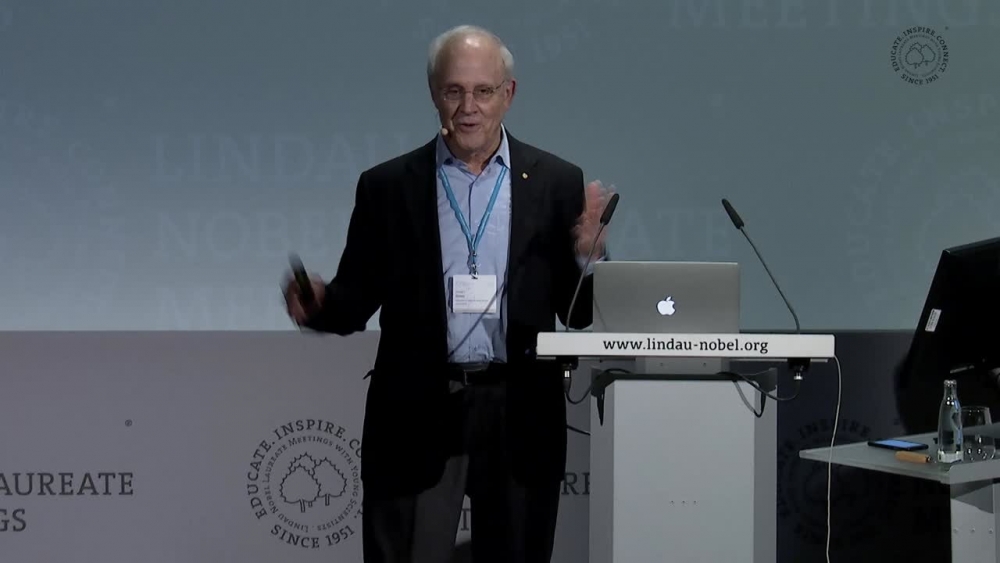
A Meeting of Minds
It’s a once-in-a-lifetime opportunity for four students and one postdoctoral scholar from UC Santa Barbara: They are among 580 young scientists from 88 countries selected to participate in the 69th Lindau Nobel Laureate Meeting from June 30 to July 5.
The five young scientists and engineers who will have the opportunity to meet — and learn from — 41 Nobel laureates include materials science graduate students Joshua Bocarsly and Elayne Thomas. Joining them are physics postdoctoral researcher Yu Saito, graduate student Jared Goldberg and undergraduate Dolev Bluvstein.
This year’s meeting is dedicated to physics, with key topics including laser physics, cosmology and gravitational waves.
Since 1951, Nobel laureates in chemistry, physics, physiology and medicine have convened annually in Lindau, which is located at the border of Austria, Germany, and Switzerland. The distinguished scientists meet with undergraduate and graduate students, post-docs, and young researchers in an informal setting. Mornings are filled with lectures from the laureates on topics of their choice followed by group discussions for the remainder of the day. A select number of students will also have the opportunity to present their research to the laureates, who will offer their feedback and advice.
“I am honored to be a part of a community that connects young minds with those who are unraveling the mysteries of the world and have received the highest honor in science,” said Thomas. “A former lab-mate went to the 65th Lindau meeting and had an incredible time connecting with other talented students around the world. I am ecstatic to participate in and continue this tradition.”
In addition to attending presentations, Thomas is most excited for the opportunity to meet other young researchers from around the world. “Learning more about different approaches to science in a diverse community, such as the Lindau Meeting, can further guide how I approach problems in my own research,” she said.
Thomas’s research focuses on doped polymeric semiconductors. Doping refers to adding small molecules to oxidize or reduce a polymer, which generates charge carriers to conduct electricity. She studies how the presence of the dopants influences the material’s electronic and crystalline structure.
Bluvstein echoed Thomas’ sentiment. “I think it’s very easy for all of us to get holed up in our specific niches,” said Bluvstein, a College of Creative Studies student who researches defects in diamonds for use as quantum sensors. “It’s healthy to break out and see what everybody else is doing. Getting a broader perspective allows us to look at our own problems in new ways and reevaluate the impact of our own subfields.”
UC Santa Barbara will be one of the most well-represented American universities in Lindau, accounting for five of the 67 young scientists selected from American institutions. According to the organizers, 33 young scientists from UC Santa Barbara have been invited to the Lindau Meeting since 2004.
“Considering the excellent group of applicants, the selection proved to be very challenging,” says Rainer Blatt, a professor at the University of Innsbruck’s Institute of Experimental Physics. He is one of two scientific chairmen of this year’s meeting.
For some, the magnitude of the event is still setting in. “I found out I was selected while I was in 12 hours of meetings with my research group,” said Goldberg, who uses computational models to study supernovae. “My initial reaction was, ‘Uh, wow, that's amazing! I'm beyond honored, grateful, and excited for this opportunity. I'll have to process this later. Back to work.’”
Goldberg believes the experience will help him develop his communication skills when conversing with both scientists and non-scientists. “I want to be exposed to the ways that others make their work accessible and exciting to a broader audience, which I can then weave into my own outreach and explanations,” he said.
The five young scientists won’t be the UC Santa Barbara’s only representatives in Lindau this summer. David Gross, the Chancellor’s Chair in Theoretical Physics and former director of the campus’s Kavli Institute for Theoretical Physics, will be among the 41 Nobel laureates at the event. Gross received the 2004 Nobel Prize in physics for discovering asymptotic freedom in the theory of the strong interaction.



